If you are looking at moving workloads to the cloud – you should stop and read this first. Deploying an on-premises private cloud built on blade servers could save some major time and offer cost savings. Of course, there are use cases where public cloud makes sense, and others where having an on-premise solution makes sense. Here is one of those cases.
Tag Archives: FX2
Blade Server Options for VMware vSAN ReadyNode
Last July I wrote a blog article showcasing the limited options listed on VMware’s vSAN ReadyNode listing. Over the past 14 months, that list has grown so instead of updating that older post, I thought I’d provide a consolidated updated list of vSAN ReadyNode blade servers.
Dell vs Cisco – New Tolly Report (updated)
UPDATED – Tolly Enterprises recently published a new Tolly Report comparing Dell PowerEdge FX2 with Cisco UCS showing results favoring Dell. The 17 page document provides background on each of the product architectures and tests them in four test cases. Continue reading
5 Modes of the Dell FN IO Module
 Dell’s FN I/O Modules (FN IOMs) are integrated devices that sit in the rear of the FX2 chassis and behave like traditional network switches. The FN IOMs provide 8 x 10GbE internal ports to the connected server nodes while offering 4 x 10GbE external links for upstream connectivity. What makes the FN I/O Module unique is that it supports 5 operational modes: Standalone (SMUX), VLT, Stacking, Programmable MUX (PMUX) and Full-switch. Below are details on each of these modes.
Dell’s FN I/O Modules (FN IOMs) are integrated devices that sit in the rear of the FX2 chassis and behave like traditional network switches. The FN IOMs provide 8 x 10GbE internal ports to the connected server nodes while offering 4 x 10GbE external links for upstream connectivity. What makes the FN I/O Module unique is that it supports 5 operational modes: Standalone (SMUX), VLT, Stacking, Programmable MUX (PMUX) and Full-switch. Below are details on each of these modes.
Dell PowerEdge FX2 Solution Increased Density and Simplified Setup vs HP Solution
A newly released paper from Principled Technologies shows the Dell PowerEdge FX2 took 133 fewer steps to deploy 42 servers vs an HP server solution in 62.8% less time.
Why You May Not Want to Buy a Blade Server
UPDATED 3.25.16 In case you are new here, I’m a big fan of blade servers, however there is one situation where you’ll probably want to avoid them.
A First Look at Dell’s FX Architecture
Today Dell announced a new server architecture that combines characteristics of both rack servers and blade servers into a new architecture, known as PowerEdge FX. Today I’ll give you a first look into the platform. First off – according to Dell’s Product Development team, this platform was not designed to replace Dell’s blade server portfolio. Instead it was created to help bridge the gap between blade servers and rack servers. As you look at this new infrastructure, you may ask is it really a “blade server?” I’ve always claimed if it shared power, cooling and networking, it’s a “blade server” however I’ll let you form your own opinion. Continue reading